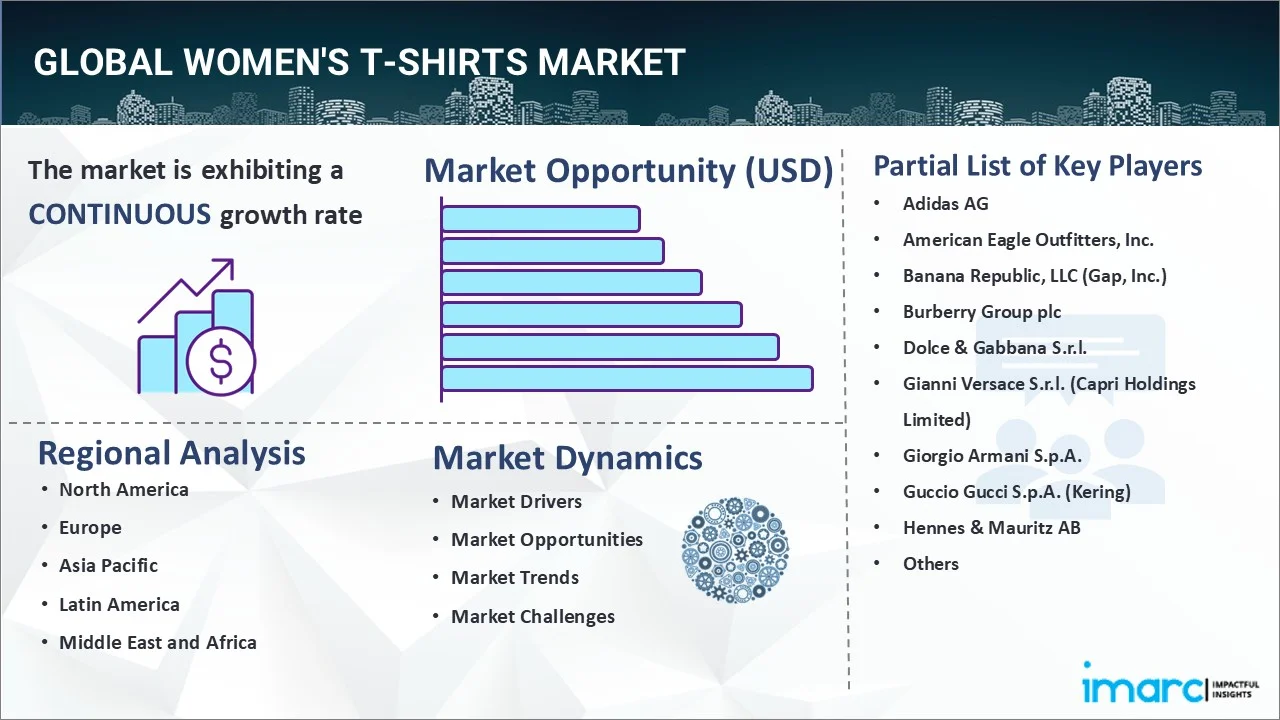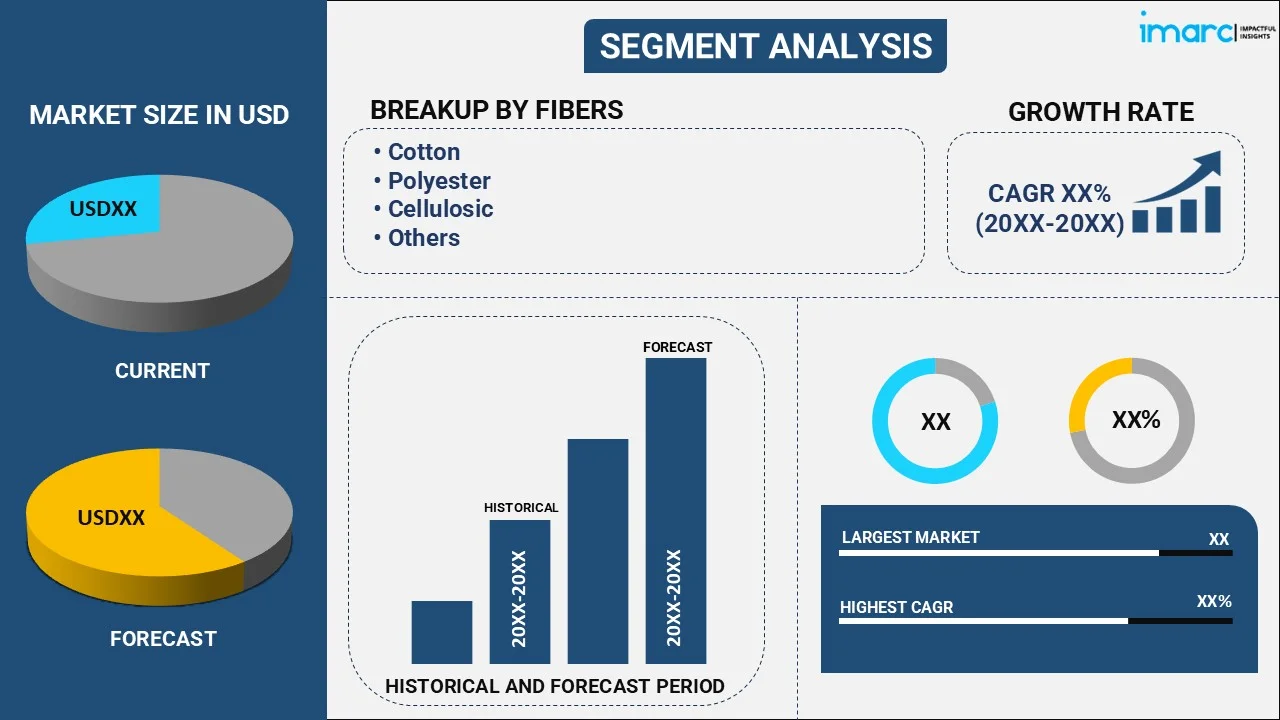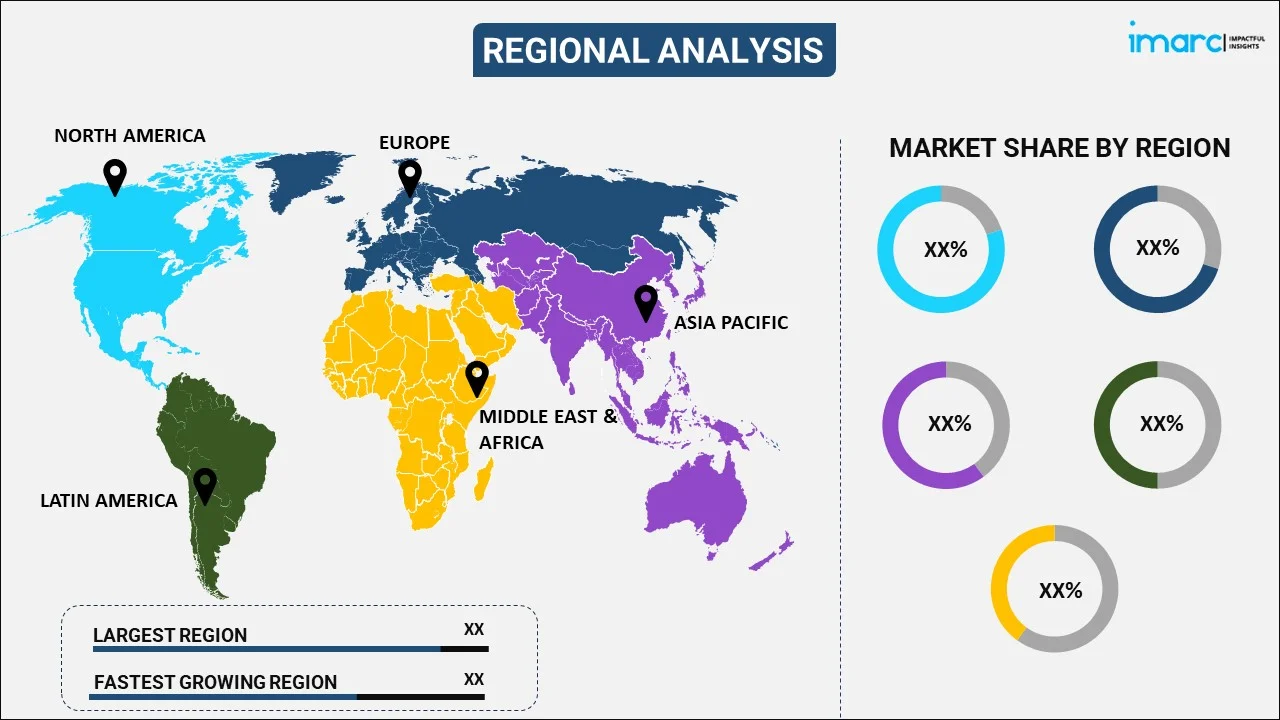
Women's T-Shirts Market Report by Fiber (Cotton, Polyester, Cellulosic, and Others), Distribution Channel (Online, Offline), and Region 2025-2033
Market Overview:
The global women's t-shirts market size reached USD 135.6 Billion in 2024. Looking forward, IMARC Group expects the market to reach USD 209.0 Billion by 2033, exhibiting a growth rate (CAGR) of 4.92% during 2025-2033. The evolving fashion trends, rise in the e-commerce sector, rapid technological advancements, increasing collaborations, growing focus on sustainability, widespread popularity of personalization and customization, changing consumer preference and lifestyle, and the rising disposable income are some of the major factors propelling the market.
|
Report Attribute
|
Key Statistics
|
|---|---|
|
Base Year
|
2024 |
|
Forecast Years
|
2025-2033
|
|
Historical Years
|
2019-2024
|
| Market Size in 2024 | USD 135.6 Billion |
| Market Forecast in 2033 | USD 209.0 Billion |
| Market Growth Rate (2025-2033) | 4.92% |
Women's T-shirts are a popular clothing item specifically designed for the female body, characterized by their lightweight fabric. They are commonly in various necklines, including crew neck, V-neck, scoop neck, and long-sleeved, allowing for diverse styles and preferences. Women's t-shirts come in a wide range of styles, colors, patterns, and designs to suit various tastes and occasions. They also offer numerous benefits, such as versatility in design, affordability, ease of maintenance, adaptability across seasons, comfort in various climatic conditions, suitability for different body types. Moreover, they can also be adorned with various embellishments such as graphics, prints, embroidery, sequins, and rhinestones, allowing for a diverse array of aesthetic options.

The constant evolution in fashion trends as designers continually create innovative styles and patterns is one of the major factors driving the market growth. Additionally, the surge in online shopping platforms making it easier for consumers to access a wide variety of T-shirt styles from different brands, enhancing the availability and ease of purchase, is positively impacting the market growth. Moreover, the increasing focus on sustainability and ethical production leading to the development of eco-friendly t-shirts made from organic or recycled materials is propelling the market growth. In addition to this, the widespread availability of personalized t-shirts with unique designs, logos, or slogans, particularly for corporate promotions and special events, is providing a considerable boost to the market growth. Besides this, rapid advancements in printing and manufacturing technologies enabling intricate designs and quality production are contributing to the market growth.
Women's T-shirts Market Trends/Drivers:
Increasing evolution in fashion trends
The growing evolution in fashion trends as designers introduce innovative styles, patterns, and materials, catering to the varied tastes of consumers, is propelling the market growth. Moreover, the increasing collaborations with prominent designers or celebrities enhancing the appeal, making high-fashion accessible through t-shirts, is providing a considerable boost to the market growth. Additionally, the blending of traditional motifs with contemporary designs bridging generational gaps, making T-shirts appealing to various age groups, is supporting the market growth. Besides this, the increasing trend of eco-conscious designs, resonating with a growing segment of environmentally aware consumers aligning with global fashion movements, reflecting current cultural expressions and individual identities, is positively impacting the market growth.
Rise in e-commerce sector
The increasing availability of a vast array of online brands, styles, and sizes, across various e-commerce platforms is positively impacting the market growth. In addition to this, the rising adoption of online exclusive sales, subscription models, and targeted advertising based on browsing habits further incentivize online shopping, creating a positive outlook for the market growth. Furthermore, the growing advancements in logistics, faster shipping, and easy return policies reducing the barriers to online purchases are supporting the market growth. Additionally, the integration of secure payment gateways building consumer trust as smartphones become ubiquitous, is creating a positive outlook for the market growth. In line with this, the synergy between online marketplaces and social media facilitating a seamless shopping experience and influencing consumer purchasing decisions is providing a thrust to the market growth.
Rising environmental concerns
The increasing concerns among consumers about the environmental and social impacts of purchases are driving the market growth. Additionally, the growing demand for t-shirts made from organic, recycled, or sustainably sourced materials is propelling the market growth. Moreover, the increasing adoption of transparent manufacturing processes, reducing waste, and conserving energy is positively impacting the market growth. In addition, the credibility of certifications, such as fair trade and global organic textile standard (GOTS) that assure consumers of ethical practices is supporting the market growth. Furthermore, the increasing collaborations with environmental organizations and limited-edition releases focused on ecological themes are favoring the market growth. Sustainable T-shirts often come with a narrative about the positive impact of purchase, creating an emotional connection with the consumer. Besides this, the rise of “slow fashion,” emphasizing quality and longevity over fast, disposable trends, is creating a positive outlook for the market growth.
Women's T-shirts Industry Segmentation:
IMARC Group provides an analysis of the key trends in each segment of the global women's t-shirts market report, along with forecasts at the global, regional, and country levels for 2025-2033. Our report has categorized the market based on fiber and distribution channel.
Breakup by Fiber:

- Cotton
- Polyester
- Cellulosic
- Others
Polyester dominates the market
The report has provided a detailed breakup and analysis of the market based on the fiber. This includes cotton, polyester, cellulosic and others. According to the report, polyester represented the largest segment.
Polyester is a synthetic fiber particularly in the production of T-shirts, due to its numerous advantageous properties. It is renowned for its strength and resilience, offering long-lasting t-shirts that are resistant to wear and tear and maintain their shape even after multiple washes. Furthermore, polyester fibers have moisture-wicking abilities, allowing them to draw sweat away from the body; particularly popular for sportswear or hot climates. Additionally, they blend well with other fibers, such as cotton-polyester, enhancing certain characteristics, such as softness, wrinkle resistance, or durability. Moreover, the material can be manufactured in various textures and finishes, allowing for a wide array of aesthetic choices, from glossy to matte appearances. In addition to this, polyester is a cost-effective alternative compared to natural fibers like cotton making it an attractive option for manufacturers and consumers.
Breakup by Distribution Channel:
- Offline
- Online
Offline hold the largest share in the market
A detailed breakup and analysis of the market based on the distribution has also been provided in the report. This includes online and offline. According to the report, offline accounted for the largest market share.
Offline channels, including department stores, boutiques, and brand outlets, are dominating the market as these channels are spread across various locations, from city centers to suburban malls, making them accessible to a broad consumer base. Besides this, offline stores offer personalized assistance through trained sales staff. Their selection, sizing, and styling guidance can enhance the shopping experience, building customer loyalty. Moreover, they provide immediate possession of purchased items, which appeals to many consumers, especially with time constraints. In addition to this, the established offline stores carry an inherent trust factor, particularly among certain demographics who may be skeptical of online shopping due to concerns about fit, quality, or online fraud. Apart from this, brands with offline stores contribute significantly to their visibility and brand image. Furthermore, many retailers are embracing omnichannel strategies, where offline stores are integrated with online platforms. This interconnected approach provides a seamless shopping experience, combining the convenience of online browsing with the assurance of in-store purchases.
Breakup by Region:

- North America
- United States
- Canada
- Europe
- Germany
- France
- United Kingdom
- Italy
- Spain
- Others
- Asia Pacific
- China
- Japan
- India
- South Korea
- Australia
- Indonesia
- Others
- Latin America
- Brazil
- Mexico
- Others
- Middle East and Africa
Europe exhibits a clear dominance, accounting for the largest women's t-shirts market share
The report has also provided a comprehensive analysis of all the major regional markets, which include North America (the United States and Canada); Europe (Germany, France, the United Kingdom, Italy, Spain, and others); Asia Pacific (China, Japan, India, South Korea, Australia, Indonesia, and others); Latin America (Brazil, Mexico, and others); and the Middle East and Africa. According to the report, Europe accounted for the largest market share.
Europe is dominating the women’s t-shirts market as fashion-conscious consumers exhibit a strong preference for trendy and comfortable clothing. Besides this, the well-established retail infrastructure and growing e-commerce channels in Europe provide easy accessibility to a wide range of women's t-shirts. Moreover, the strong economy in major European countries allow consumers to spend on clothing and fashion translating into higher purchase rates. Along with this, the cultural appreciation for fashion and personal expression through clothing in Europe contributes to the sustained interest in clothing items. Apart from this, it leads in the adoption of sustainable practices as brands offer eco-friendly t-shirts, appealing to environmentally-conscious consumers. Furthermore, the favorable trade agreements and regulations also facilitate the smooth flow of goods within Europe, making women's t-shirts more accessible and affordable.
Competitive Landscape:
The leading companies in the women's t-shirts market are expanding their product lines to include a wide range of styles, designs, and materials to cater to different preferences and age groups. This includes offering various necklines, sleeve lengths, prints, and embellishments. In addition to this, manufacturers are utilizing sustainable production methods, using organic, recycled, or eco-friendly materials, and ensuring ethical labor practices. They are also focusing on transparency about sourcing and manufacturing processes appealing to conscious consumers. Besides this, some companies are adopting advanced technology in design, manufacturing, and supply chain management, such as artificial intelligence (AI) and three-dimensional (3D) printing for design and customization, while others are leveraging big data to forecast trends and manage inventory. Apart from this, several key players are strengthening e-commerce platforms, offering seamless online shopping experiences, virtual try-on, and personalized recommendations facilitating a closer connection with consumers. Additionally, many leading brands collaborate with designers, celebrities, or influencers to create limited editions, exclusive lines, or simply to enhance brand visibility and appeal.
The report has provided a comprehensive analysis of the competitive landscape in the market. Detailed profiles of all major companies have also been provided. Some of the key players in the market include:
- Adidas AG
- American Eagle Outfitters, Inc.
- Banana Republic, LLC (Gap, Inc.)
- Burberry Group plc
- Dolce & Gabbana S.r.l.
- Gianni Versace S.r.l. (Capri Holdings Limited)
- Giorgio Armani S.p.A.
- Guccio Gucci S.p.A. (Kering)
- Hennes & Mauritz AB
- J.Crew
- LVMH Moët Hennessy Louis Vuitton
- Nike, Inc.
- Prada S.p.A.
- Zara (Inditex)
Women's T-shirts Market Report Scope:
| Report Features | Details |
|---|---|
| Base Year of the Analysis | 2024 |
| Historical Period | 2019-2024 |
| Forecast Period | 2025-2033 |
| Units | Billion USD |
| Scope of the Report | Exploration of Historical and Forecast Trends, Industry Catalysts and Challenges, Segment-Wise Historical and Predictive Market Assessment:
|
| Fibers Covered | Cotton, Polyester, Cellulosic, Others |
| Distribution Channels Covered | Online, Offline |
| Regions Covered | Asia Pacific, Europe, North America, Latin America, Middle East and Africa |
| Countries Covered | United States, Canada, Germany, France, United Kingdom, Italy, Spain, China, Japan, India, South Korea, Australia, Indonesia, Brazil, Mexico |
| Companies Covered | Adidas AG, American Eagle Outfitters, Inc., Banana Republic, LLC (Gap, Inc.), Burberry Group plc, Dolce & Gabbana S.r.l., Gianni Versace S.r.l. (Capri Holdings Limited), Giorgio Armani S.p.A., Guccio Gucci S.p.A. (Kering), Hennes & Mauritz AB, J.Crew, LVMH Moët Hennessy Louis Vuitton, Nike, Inc., Prada S.p.A., Zara (Inditex) |
| Customization Scope | 10% Free Customization |
| Post-Sale Analyst Support | 10-12 Weeks |
| Delivery Format | PDF and Excel through Email (We can also provide the editable version of the report in PPT/Word format on special request) |
Key Questions Answered in This Report:
- How has the global women's t-shirts market performed so far, and how will it perform in the coming years?
- What are the drivers, restraints, and opportunities in the global women's t-shirts market?
- What is the impact of each driver, restraint, and opportunity on the global women's t-shirts market?
- What are the key regional markets?
- Which countries represent the most attractive women's t-shirts market?
- What is the breakup of the market based on fiber?
- Which is the most attractive fiber in the women's t-shirts market?
- What is the breakup of the market based on the distribution channel?
- Which is the most attractive distribution channel in the women's t-shirts market?
- What is the competitive structure of the global women's t-shirts market?
- Who are the key players/companies in the global women's t-shirts market?
Key Benefits for Stakeholders:
- IMARC’s report offers a comprehensive quantitative analysis of various market segments, historical and current market trends, market forecasts, and dynamics of the women's t-shirts market from 2019-2033.
- The research study provides the latest information on the market drivers, challenges, and opportunities in the global women's t-shirts market.
- The study maps the leading, as well as the fastest-growing, regional markets. It further enables stakeholders to identify the key country-level markets within each region.
- Porter's five forces analysis assist stakeholders in assessing the impact of new entrants, competitive rivalry, supplier power, buyer power, and the threat of substitution. It helps stakeholders to analyze the level of competition within the women's t-shirts industry and its attractiveness.
- Competitive landscape allows stakeholders to understand their competitive environment and provides an insight into the current positions of key players in the market.
Need more help?
- Speak to our experienced analysts for insights on the current market scenarios.
- Include additional segments and countries to customize the report as per your requirement.
- Gain an unparalleled competitive advantage in your domain by understanding how to utilize the report and positively impacting your operations and revenue.
- For further assistance, please connect with our analysts.
 Inquire Before Buying
Inquire Before Buying
 Speak to an Analyst
Speak to an Analyst
 Request Brochure
Request Brochure
 Request Customization
Request Customization




.webp)




.webp)












